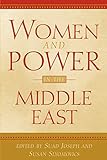Women and Power in the Middle East / ed. by Susan Slyomovics, Suad Joseph.
Material type: TextPublisher: Philadelphia : University of Pennsylvania Press, [2011]Copyright date: ©2001Description: 1 online resource (256 p.) : 22 illusContent type:
TextPublisher: Philadelphia : University of Pennsylvania Press, [2011]Copyright date: ©2001Description: 1 online resource (256 p.) : 22 illusContent type: - 9780812217490
- 9780812206906
- 305.42/0956
- HQ1726.5 ǂb W659 2001eb
- online - DeGruyter
- Issued also in print.
| Item type | Current library | Call number | URL | Status | Notes | Barcode | |
|---|---|---|---|---|---|---|---|
 eBook
eBook
|
Biblioteca "Angelicum" Pont. Univ. S.Tommaso d'Aquino Nuvola online | online - DeGruyter (Browse shelf(Opens below)) | Online access | Not for loan (Accesso limitato) | Accesso per gli utenti autorizzati / Access for authorized users | (dgr)9780812206906 |
Frontmatter -- Contents -- Introduction -- Overviews -- Women's Activism in the Middle East -- Women and Politics in the Middle East -- Women and Work in the Arab World -- The Politics of Gender and the Conundrums of Citizenship -- II. Country Case Studies, West to East -- State and Gender in the Maghrib -- Sex, Lies, and Television -- An Interview with Heba Ra¡uf Ezzat -- Women on Women: Television Feminism and Village Lives -- Sudanese Women and the Islamist State -- For the Common Good? -- Women and the Palestinian Movement: No Going Back? -- Searching for Strategies -- Gender and Citizenship -- Women in Saudi Arabia -- Women's Organizations in Kuwait -- The Dialectics of Fashion -- The Political Economy of Female Employment in Postrevolutionary Iran -- Notes -- Bibliography -- Contributors -- Acknowledgments
restricted access online access with authorization star
http://purl.org/coar/access_right/c_16ec
The seventeen essays in Women and Power in the Middle East analyze the social, political, economic, and cultural forces that shape gender systems in the Middle East and North Africa. Published at different times in Middle East Report, the journal of the Middle East Research and Information Project, the essays document empirically the similarities and differences in the gendering of relations of power in twelve countries-Morocco, Algeria, Tunisia, Egypt, Sudan, Palestine, Lebanon, Turkey, Kuwait, Saudi Arabia, Yemen, and Iran. Together they seek to build a framework for understanding broad patterns of gender in the Arab-Islamic world. Challenging questions are addressed throughout. What roles have women played in politics in this region? When and why are women politically mobilized, and which women? Does the nature and impact of their mobilization differ if it is initiated by the state, nationalist movements, revolutionary parties, or spontaneous revolt? And what happens to women when those agents of mobilization win or lose? In investigating these and other issues, the essays take a look at the impact of rapid social change in the Arab-Islamic world. They also analyze Arab disillusionment with the radical nationalisms of the 1950s and 1960s and with leftist ideologies, as well as the rise of political Islamist movements. Indeed the essays present rich new approaches to assessing what political participation has meant for women in this region and how emerging national states there have dealt with organized efforts by women to influence the institutions that govern their lives.Designed for courses in Middle East, women's, and cultural studies, Women and Power in the Middle East offers to both students and scholars an excellent introduction to the study of gender in the Arab-Islamic world.
Issued also in print.
Mode of access: Internet via World Wide Web.
In English.
Description based on online resource; title from PDF title page (publisher's Web site, viewed 24. Apr 2022)


